
Magna Carta Libertatum, commonly called Magna Carta, is a royal charter of rights agreed to by King John of England at Runnymede, near Windsor, on 15 June 1215. First drafted by Archbishop of Canterbury Stephen Langton to make peace between the unpopular king and a group of rebel barons, it promised the protection of church rights, protection for the barons from illegal imprisonment, access to swift justice, and limitations on feudal payments to the Crown, to be implemented through a council of 25 barons. Neither side stood behind their commitments, and the charter was annulled by Pope Innocent III, leading to the First Barons' War.

The eastern meadowlark is a medium-sized icterid bird, very similar in appearance to the western meadowlark. It occurs from eastern North America to South America, where it is also most widespread in the east.
Latin honors are Latin phrases used in some colleges and universities to indicate the level of distinction with which an academic degree has been earned. This system is primarily used in the United States. It is also used in some Southeastern Asian countries with European colonial history, such as Indonesia and the Philippines, although sometimes translations of these phrases are used instead of the Latin originals. The honors distinction should not be confused with the honors degrees offered in some countries, or with honorary degrees.

Magna International Inc. is a Canadian mobility technology company for automakers. It is one of the largest companies in Canada and was recognized on the 2020 Forbes Global 2000. The company is the largest automobile parts manufacturer in North America by sales of original equipment parts, it has ranked consistently in the Fortune Global 500 list for 20 years in a row since 2001. It produces automotive systems, assemblies, modules, and components, which are supplied to General Motors, Ford Motor Company and FCA, as well as BMW, Mercedes, Volkswagen, Toyota, Tesla, and Tata Motors, among others.

Runnymede is a water-meadow alongside the River Thames in the English county of Surrey, and just over 20 miles (32 km) west of central London. It is notable for its association with the sealing of Magna Carta, and as a consequence is, with its adjoining hillside, the site of memorials. Runnymede Borough is named after the area, Runnymede being at its northernmost point.

Actiniidae is the largest family of sea anemones, to which most common, temperate, shore species belong. Most members of this family do not participate in symbioses with fishes. Three exceptions are the bubble-tip anemone, snakelocks anemone and Urticina piscivora.

The greater guinea pig is a species of rodent found in the coastal strip of Brazil and Uruguay, where it lives in moist grassland and marshes.
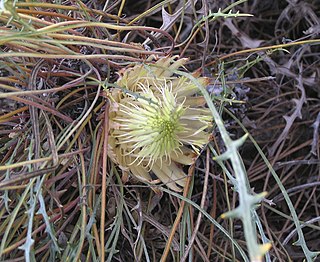
Banksia rufa is a species of prostrate shrub that is endemic to the south-west of Western Australia. It has broadly linear, pinnatifid or pinnatipartite leaves with between five and twenty lobes on each side, yellow, orange or brownish flowers in heads of forty or more, and glabrous, egg-shaped follicles.
Przevalski's partridge or the rusty-necklaced partridge, is a bird species in the family Phasianidae. It is found only in China.

The streaked spiderhunter is a species of bird in the family Nectariniidae.
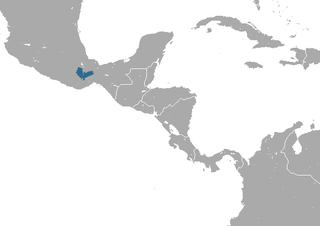
The big Mexican small-eared shrew is a species of mammal in the family Soricidae. It is endemic to Mexico.

The greater yellow-shouldered bat is a species of bat in the family Phyllostomidae. It is found in Bolivia, Colombia, Ecuador, and Peru.

Bithionol is an antibacterial, anthelmintic, and algaecide. It is used to treat Anoplocephala perfoliata (tapeworms) in horses and Fasciola hepatica.
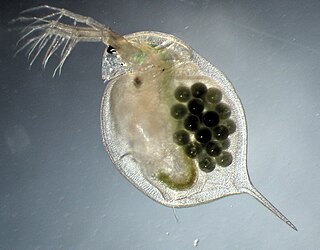
Daphnia magna is a small planktonic crustacean that belongs to the subclass Phyllopoda. It inhabits a variety of freshwater environments, ranging from acidic swamps to rivers made of snow runoff, and is broadly distributed throughout the Northern Hemisphere and South Africa.
Similodonta is an extinct genus of early bivalve in the extinct family Praenuculidae. The genus is one of eleven genera in the subfamily Praenuculinae. Similodonta is known from Middle Ordovician through Middle Silurian fossils found in Europe and North America. The genus currently contains eight accepted species, Similodonta ceryx, Similodonta collina, Similodonta djupvikensis, Similodonta magna, Similodonta recurva, Similodonta spjeldnaesi, Similodonta wahli and the type species Similodonta similis.

Anoplocephala perfoliata is the most common intestinal tapeworm of horses, and an agent responsible for some cases of equine colic.

Lepidoperca is a small genus of fish belonging to the Anthiinae subfamily. It includes ten species.
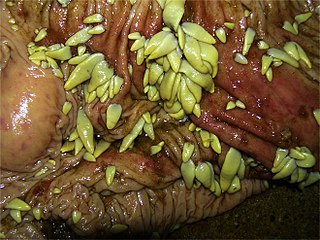
The Anoplocephalidae are a family of tapeworms containing the genera Bertiella, Anoplocephala, Paranoplocephala, Moniezia, and others.

Anoplocephala is a genus of tapeworms in the family Anoplocephalidae named in 1848 by Émile Blanchard. The type species is Anoplocephala perfoliata, which was originally described as Taenia perfoliata. Anoplocephala is a cestode, belonging to the Cestoda class, meaning that it is a Flatworm parasite. They can be found in fifty-six percent of the wild rhino population in Assam, India.
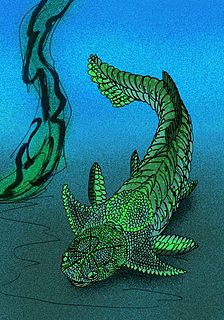
Actinolepis is an extinct genus of actinolepid placoderm from the Early Devonian. Four species are known: A. magna from Estonia, A. spinosa from Latvia, the type species A. tuberculata from New Zealand and A. zaikai from Belarus.
















